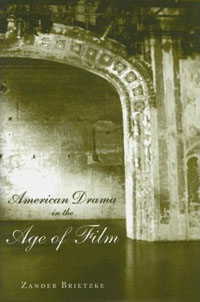 Zander Brietzke
Zander Brietzke
University of Alabama Press ($39.95)
by Justin Maxwell
This strong critical work by Columbia University Professor Zander Brietzke comprehensively and concretely parses out the idiomatic values of drama and film to show the former’s continued relevance in modern culture, while honoring the latter. Brietzke’s prose conveys his complex ideas in an articulate, accessible format; he offers intellectual depth without the linguistic miasma that often clouds academic writing. Starting with a solid premise that “the best theater is theatrical; the best film is cinematic. By that, I simply mean that a theatrical event is suited for the theater and should be seen upon a stage,” Brietzke goes on to build a worthwhile argument about the fundamental differences between the nature of the two mediums. He usefully elucidates the differences between “simultaneity” and “sequence,” noting that events on stage happen simultaneously as the audience sees things all at once, and their eyes are drawn around the stage or left free to roam, whereas film takes place in sequence, literally one frame after another, edited together to create a controlled series of images. Brietzke’s points about simultaneity and sequence lead him to explore a larger idea of spectacle, which he claims fills the whole dramatic space in a way that film can’t. This idea of spectacle replaces, for Brietzke, much of the nebulous language that has been used in an attempt to validate drama and differentiate it from celluloid. As he says, “it is very difficult to know what ‘chemistry,’ ‘magic,’ and ‘special quality’ are, and yet the theater world is filled with such empty medieval rhetoric.”
The fundamental argument of the text is hearty reading, and takes up the first two chapters of the book. Beyond these chapters the emphasis changes from offering a well-reasoned (albeit abstract) thesis to exploring concrete manifestations of the three aforementioned ideas. Each of Brietzke’s subsequent ten chapters takes on a different playwright whose stage work also exists on film. The writing is lively and thorough: each chapter uses different internal structures, sometimes ranging over an author’s oeuvre, such as the chapter on August Wilson’s The Piano Lesson, sometimes focusing on a single work, such as the chapter on Edward Albee’s Who’s Afraid of Virginia Woolf. This keeps the book from plodding along or becoming dryly formulaic. Unfortunately, because Brietzke is pointing out different manifestations of the same core concepts, once he’s convinced the reader of their veracity whatever else comes after that point makes the book feel excessive. This tautological approach is perhaps a necessary evil, since the author can’t know where any given reader might be won over. Consequently, American Drama in the Age of Film is a valuable and insightful book but one that some readers may not need to read in its entirety, despite its accessibility.
Click here to buy this book from Amazon.com
Click here to buy this book from Powells.com
Rain Taxi Online Edition, Summer 2008 | © Rain Taxi, Inc. 2008
